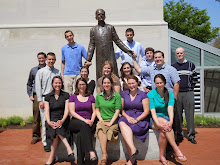Wednesday, February 25, 2015
What is sexual difference? Part II
Time for the Family
2/25/2015
Define Your Terms
,
EMacke
,
Gender
,
Love
,
Sexual difference
,
Trinity
No comments
:
Sexual
difference is one of the most contentious topics today. We toss around the word “gender” with a
panoply of meanings, though each person professes the utmost confidence that
his (or should we use the gender
neutral “hen”?) understanding of the term is the most accurate.
So, in a
quest to understand what sexual difference is and why it matters, we are
carefully defining our terms. This post
is the second in a series.
In Part I of our
reflections, we looked at who God is and summarized that He is relational, has
unity and difference (three Persons, one God) and that within God there is both
giving and receiving. In Part III we
will focus on the visible ways in which we can see the Trinitarian stamp in
humanity, but first we must take a quick (and confessedly inadequate) primer in
metaphysics. To understand why the
visible has an inherent logic and meaning, we must understand something of the invisible behind it.
In
Ancient Greece, the philosopher Aristotle asked the question, “What is
being?” He came to understand it as
composed of two things – each necessary for a thing to exist, but not reducible
to each other – form and matter.
Form is
the principle of unity. It is what
actuates a thing. Because a thing has
form, it cannot be “mere matter.”
Therefore, a whole is greater than its parts. A person is still a person if his finger is
cut off. Likewise, a frog dissected in
biology class cannot be magically put back together again as a living frog.
Matter is
the material. In modernity, this tends
to be that to which things are reduced, because form, is in a sense taken for
granted: if it gives matter its being, then we think all we see is just matter. But if things were merely matter, they could
not exist.
Fast
forward from Aristotle to St. Thomas Aquinas.
Instead of beginning with the question, “What is being?” he wanted to
know why things exist. For Aristotle,
the world was eternal and therefore it seemed an irrelevant question. But for Aquinas, who believed that the world
was created out of nothing, this was an important question with which to
begin.
 |
| "Angels at Mamre (Holy Trinity)" by Rublev is in the Public Domain |
St.
Thomas Aquinas had a more comprehensive notion of what it means to be, which includes
the “real distinction.” An existent or
entity is composed of esse (being or “that a thing is” and essence (“what a
thing is”). Essence is composed of form
and matter. So, for Aquinas there are
three dimensions of a particular being – esse, form and matter.
Though
belief in what is immaterial has always been part of humanity, there has been a
shift in the last several centuries to not take these immaterial realities
seriously. In many ways we seek value
only in what is provable through experiment and what is tangible or makeable. Metaphysics is not visible and therefore is
not seen as true or as valuable. But it’s
vital for a full and philosophical explanation of the human person to understand
what form is. When it is denied by the
world at large, we miss out on huge implications of who the human person truly
is.
In
answering the question, “What is sexual difference?” we start with God who is
eternal Gift, a Communion of Persons in which the Father gives to the Son, the
Son receives the Father and gives Himself in return, and the Holy Spirit is the
love that they share. In Genesis 1, the
pattern of God creating and then saying, “It is good” is interrupted before the
creation of man. Here, God pauses and
looks into Himself, seeking in a sense the “blueprint” for the creation of the
human person in His own image and likeness.
There is a “Trinitarian logic” at the ground of the human person, both
physically and metaphysically. Esse/being
in all its fullness gives itself to existents/entities and “receives” from
them. Likewise, form – although
invisible – gives shape to matter, which in turn receives and instantiates
form. This logic of gift is then made
visible in our male and female bodies. God
has not only given us the gift of
ourselves but also the ability to give – a reflection of and a
participation in His own generosity and love.
In our next post in this series we will look more closely at the meaning of sexual difference and what our masculinity and femininity reveal to us about being human.
Subscribe to:
Post Comments
(
Atom
)
















No comments :
Post a Comment
We would love to hear from you! Please keep comments respectful and relevant to the topic at hand.